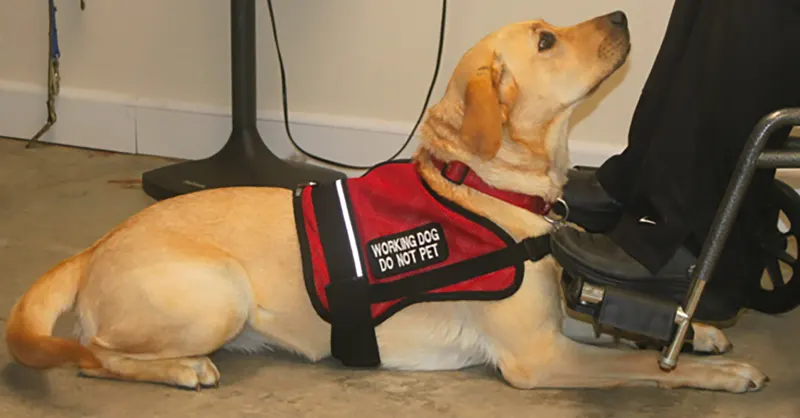Archive for the ‘Psychiatric Service Dog’ Category
A service dog letter comes from a licensed health professional and confirms a service dog handler has an eligible condition. These letters are often obtained by handlers who need psychiatric service dogs, also known as PSD letters.
This guide will walk you through how to obtain a service dog letter and the reasons to consider one.
Steps to Get a Letter for Your Service DogIf you’re interested in a service dog letter, your first resource should be your existing doctor or therapist. Inform them that you are requesting a signed letter that contains their opinion about whether your health condition meets the definition of “disability” under the ADA.
Here are some steps you can take to get a service dog letter:
Find a healthcare professionalSeek out a licensed health professional who understands your needs and the role of service dogs.
Discuss your needsDiscuss the role of your service dog and request a formal letter stating your need for the service dog.
Obtain the letterThe letter should be written on the provider’s letterhead, indicating their professional details (such as licensing information) and confirming you have an ADA-eligible disability.
Update regularlyKeep the letter current and renew it periodically. While there’s no set expiry for these letters, keeping them up-to-date is good practice.
Benefits of Having a Service Dog LetterAlthough the Americans with Disabilities Act (ADA) confirms that service dog owners don’t need to carry any documentation to prove their dog’s status, obtaining a letter from a therapist can have certain advantages.
Confirming eligibility: A service dog letter is primarily used to document proof that a person has an ADA-eligible condition. This is especially desirable for PSD owners who have invisible disabilities. There can be consequences for falsely misrepresenting yourself as eligible for a service dog, so many handlers want additional proof. Facilitating understanding: An official letter can speed up clarifying any misconceptions about your service dog’s role, even in situations where the ADA’s regulations apply. Enhancing personal comfort: Having an official letter can help answer questions about your service dog without needing to disclose additional personal health information. International usage: Some countries and foreign airlines require letters from a licensed healthcare provider as part of their assistance animal verification process. Protecting your rights: If your rights under the ADA are ever challenged, having an official letter can provide additional support.Keep in mind that no third party can make having a service dog letter a condition for entry. Service dog letters are obtained at the discretion of handlers and for their personal convenience.
No documentation is ever required to prove you have a service dog, except for the DOT’s Service Animal Form when boarding flights.
Dealing with Attention Deficit Hyperactivity Disorder (ADHD) can sometimes feel like a rollercoaster ride. From racing thoughts to difficulty focusing and maintaining attention, navigating daily life can be challenging.
ADHD is a common affliction, but for some, the condition can be debilitating, particularly if they have ADHD in conjunction with other mental or physical health issues. Someone with ADHD alone or in combination with other health issues can be considered disabled if their condition significantly impairs their ability to conduct major life activities.
For these disabled individuals, a service dog can provide invaluable assistance in managing their ADHD.
How does a service dog help with ADHD?Service dogs, especially psychiatric service dogs (PSD), can be a real game-changer for people with ADHD. They offer support, structure, and friendship. Here’s a brief look at how a PSD can help someone with ADHD:
Boosting focus: A PSD can sense when their handler’s attention drifts and gently nudge them back on track. Emotional balance: The calming presence of a PSD helps manage emotions, reduce anxiety, and ease stress. Promoting routine: Caring for a PSD encourages a structured daily schedule, which can help manage ADHD symptoms. Social support: A PSD can make social situations more manageable and boost their handler’s self-confidence. Tailored tasks: PSDs can learn specific tasks to assist with an individual’s unique ADHD challenges, like reminders or organization. Public space navigation: With a PSD’s support, handlers can feel more at ease in public places and focus on social interactions. How do I know if I’m eligible for a service dog?To be eligible for a psychiatric service dog, you must have a mental health disability. Not only that, but your disability must require the assistance of a task-trained service dog.
Need help to determine whether you qualify? Talk to your therapist or doctor about your condition. They may also be able to help you with a PSD letter which contains their evaluation of whether you meet the ADA disability criteria.
What is better for anxiety, a service dog or an emotional support animal? The answer depends on many factors, but perhaps the most important distinction is the following:
A psychiatric service dog (PSD) is more appropriate when the handler requires the dog to perform specially trained tasks directly related to the handler’s anxiety. An emotional support animal (ESA) is more appropriate when the animal provides comfort just by being present in the life of their owner. Who qualifies for a service dog for anxiety?To qualify for a psychiatric service dog for anxiety, the handler’s condition must rise to the level of a disability. That means the handler’s anxiety (by itself or in combination with other disorders) must substantially impair a major life activity.
In addition, psychiatric service dogs undergo extensive training to learn a job or task relating to the handler’s condition. For example, an anxiety service dog can perform tasks like providing tactile comfort during times of crisis, interrupting panic attacks, or retrieving medication.
Psychiatric service dogs have the ability to venture into areas normally closed off to dogs. They also have housing rights – PSDs can live in housing complexes that ban pets without paying pet fees. PSDs can also fly in the cabin of airplanes free of charge.
Who qualifies for an emotional support animal for anxiety?To qualify for an emotional support animal, the owner must also have an eligible psychiatric disability. However, the major difference between an ESA and a service dog is that an ESA does not need individualized training.
ESAs provide comfort for anxiety just by being around their owners. ESAs can also be many types of animals, such as dogs, cats, rabbits, birds, and fish. On the other hand, only dogs can qualify as service animals.
To qualify for an ESA, the owner must have an ESA letter from their licensed healthcare professional. ESAs have housing rights under federal law that allow them to live with their owners in no-pets buildings free of charge.
Final ThoughtsThere are many things to consider if you want to pursue a service dog or ESA ownership for anxiety. You should ask the following questions:
Do I need a dog or other type of animal? Does my disabling anxiety require a trained dog to perform specialized tasks? Do I need my dog for housing, travel, public access, or a combination? Do I have the ability to train or hire someone to train a service dog? Does my dog have the temperament and ability to be a service dog or ESA?If you’re unsure whether your condition qualifies for a service dog or ESA, speak to your licensed healthcare professional. If you want to qualify for an ESA letter, you will eventually need the involvement of a licensed mental health professional. There is no documentation requirement for PSDs, but many owners find comfort in a PSD letter that affirms their need for a psychiatric service dog.







